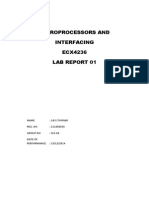Microprocessor based System Design Laboratory (Gy)
Department of Computer Science and Technology, IIEST Shibpur
Date: September 08, 2023
Experiment No. 7: Working with the SID line of 8085 and 8255 PPI
Objective: To write 8085 Assembly Language Programs to handle serial input through SID line and
to interact with IO devices through 8255 Programmable Peripheral Interface.
1. Complete assignments of the previous class (namely, (i) rotation (left to right) of a pattern
occupying all 6 module of the display section; and (ii) monitoring the status of the SID line
of 8085 in your SDK)
2. In an infinite loop, read from Port B of one of the 8255 chips (interfaced at Port 00H-03H or
40H-43H. Please check which is available) of your MPS-3 Kit and display the data in the
data field of the 7-segment LED display.
Consult the Pin configuration of the J1/J2 connector of the Kit. Connect a flat cable to
the J1/J2 connector and supply input to Port B through the other end of the cable.
Connect the Ground/Vcc of the J1/J2 connector (from the other end of the Flat cable)
to a breadboard and use them to supply input to Port B.
3. In an infinite loop, read from PB7 pin of Port B of one of the 8255 chips (interfaced at Port
00H-03H or 40H-43H. Please check which is available) of your MPS 3 Kit and passes its
complement to PA7 of Port A of the same 8255 chip. Use an LED to display the bit at PA7.
Consult the Pin configuration of the J1/J2 connector of the Kit. Connect a flat cable to
the J1/J2 connector and supply input to Port B through the other end of the cable.
Connect the Ground/Vcc of the J1/J2 connector (from the other end of the Flat cable)
to a breadboard and use them to supply input to Port B. Connect the LED too at the
breadboard only in between PA7 and Vcc / Gnd through a resistor.
4. Generate a clock signal at PA7 pin of Port A of one of the 8255 chips (interfaced at Port
00H-03H or 40H-43H. Please check which is available) of your MPS 3 Kit. The frequency
of the clock is determined by the input (00H – FFH) fed at Port B of the same 8255 chip,
FFH will trigger the “slowest” clock. The data to be read form Port B after one clock period
of the present clock signal. Use an LED to demonstrate the clock generated at PA7.
Analyze your program to compute the frequency of the clock signal being generated.
Consult the Pin configuration of the J1/J2 connector of the Kit. Connect a flat cable to
the J1/J2 connector and supply input to Port B through the other end of the cable.
Connect the Ground/Vcc of the J1/J2 connector (from the other end of the Flat cable)
to a breadboard and use them to supply input to Port B. Connect the LED too at the
breadboard only in between PA7 and Vcc / Gnd through a resistor.
























































































